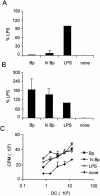Bordetella pertussis-infected human monocyte-derived dendritic cells undergo maturation and induce Th1 polarization and interleukin-23 expression
- PMID: 15731058
- PMCID: PMC1064915
- DOI: 10.1128/IAI.73.3.1590-1597.2005
Bordetella pertussis-infected human monocyte-derived dendritic cells undergo maturation and induce Th1 polarization and interleukin-23 expression
Abstract
Bordetella pertussis, the causative agent of whooping cough, is internalized by several cell types, including epithelial cells, monocytes, and neutrophils. Although its ability to survive intracellularly is still debated, it has been proven that cell-mediated immunity (CMI) plays a pivotal role in protection. In this study we aimed to clarify the interaction of B. pertussis with human monocyte-derived dendritic cells (MDDC), evaluating the ability of the bacterium to enter MDDC, to survive intracellularly, to interfere with the maturation process and functional activities, and to influence the host immune responses. The results obtained showed that B. pertussis had a low capability to be internalized by-and to survive in-MDDC. Upon contact with the bacteria, immature MDDC were induced to undergo phenotypic maturation and acquired antigen-presenting-cell functions. Despite the high levels of interleukin-10 (IL-10) and the barely detectable levels of IL-12 induced by B. pertussis, the bacterium induced maturation of MDDC and T helper 1 (Th1) polarized effector cells. Gene expression analysis of the IL-12 cytokine family clearly demonstrated that B. pertussis induced high levels of the p40 and p19 subunits of IL-23 yet failed to induce the expression of the p35 subunit of IL-12. Overall our findings show that B. pertussis, even if it survives only briefly in MDDC, promotes the synthesis of IL-23, a newly discovered Th1 polarizing cytokine. A Th1-oriented immune response is thus allowed, relevant in the induction of an adequate CMI response, and typical of protection induced by natural infection or vaccination with whole-cell vaccines.
Figures




Similar articles
-
Bordetella pertussis inhibition of interleukin-12 (IL-12) p70 in human monocyte-derived dendritic cells blocks IL-12 p35 through adenylate cyclase toxin-dependent cyclic AMP induction.Infect Immun. 2006 May;74(5):2831-8. doi: 10.1128/IAI.74.5.2831-2838.2006. Infect Immun. 2006. PMID: 16622221 Free PMC article.
-
Depletion of NK cells results in disseminating lethal infection with Bordetella pertussis associated with a reduction of antigen-specific Th1 and enhancement of Th2, but not Tr1 cells.Eur J Immunol. 2004 Sep;34(9):2579-88. doi: 10.1002/eji.200425092. Eur J Immunol. 2004. PMID: 15307190
-
The interaction of human dendritic cells with yeast and germ-tube forms of Candida albicans leads to efficient fungal processing, dendritic cell maturation, and acquisition of a Th1 response-promoting function.J Leukoc Biol. 2004 Jan;75(1):117-26. doi: 10.1189/jlb.0503226. Epub 2003 Oct 2. J Leukoc Biol. 2004. PMID: 14525965
-
Effects of IL-12 and IL-23 on antigen-presenting cells at the interface between innate and adaptive immunity.Crit Rev Immunol. 2002;22(5-6):373-90. Crit Rev Immunol. 2002. PMID: 12803317 Review.
-
Differential role of MAPK signaling in human dendritic cell maturation and Th1/Th2 engagement.J Dermatol Sci. 2006 Apr;42(1):1-11. doi: 10.1016/j.jdermsci.2005.11.004. Epub 2005 Dec 13. J Dermatol Sci. 2006. PMID: 16352421 Review.
Cited by
-
Bordetella pertussis commits human dendritic cells to promote a Th1/Th17 response through the activity of adenylate cyclase toxin and MAPK-pathways.PLoS One. 2010 Jan 15;5(1):e8734. doi: 10.1371/journal.pone.0008734. PLoS One. 2010. PMID: 20090944 Free PMC article.
-
Adenosine receptor ligation tips the uveitogenic Th1 and Th17 balance towards the latter in experimental autoimmune uveitis-induced mouse.Curr Res Immunol. 2021;2:93-103. doi: 10.1016/j.crimmu.2021.07.001. Epub 2021 Jul 26. Curr Res Immunol. 2021. PMID: 34825178 Free PMC article.
-
Dendritic cell immunizations alone or combined with low doses of interleukin-2 induce specific immune responses in melanoma patients.Clin Exp Immunol. 2005 Dec;142(3):555-68. doi: 10.1111/j.1365-2249.2005.02948.x. Clin Exp Immunol. 2005. PMID: 16297169 Free PMC article. Clinical Trial.
-
Methylation changes induced by a glycodendropeptide immunotherapy and associated to tolerance in mice.Front Immunol. 2022 Dec 14;13:1094172. doi: 10.3389/fimmu.2022.1094172. eCollection 2022. Front Immunol. 2022. PMID: 36643916 Free PMC article.
-
Bordetella pertussis inhibition of interleukin-12 (IL-12) p70 in human monocyte-derived dendritic cells blocks IL-12 p35 through adenylate cyclase toxin-dependent cyclic AMP induction.Infect Immun. 2006 May;74(5):2831-8. doi: 10.1128/IAI.74.5.2831-2838.2006. Infect Immun. 2006. PMID: 16622221 Free PMC article.
References
-
- Aste-Amezaga, M., X. Ma, A. Sartori, and G. Trinchieri. 1998. Molecular mechanisms of the induction of IL-12 and its inhibition by IL-10. J. Immunol. 160:5936-5944. - PubMed
-
- Ausiello, C. M., G. Fedele, F. Urbani, R. Lande, B. Di Carlo, and A. Cassone. 2002. Native and genetically inactivated pertussis toxins induce human dendritic cell maturation and synergize with lipopolysaccharide in promoting T helper type 1 responses. J. Infect. Dis. 186:351-360. - PubMed
-
- Ausiello, C. M., R. Lande, A. la Sala, F. Urbani, and A. Cassone. 1998. Cell-mediated immune response of healthy adults to Bordetella pertussis vaccine antigens. J. Infect. Dis. 178:466-470. - PubMed
-
- Ausiello, C. M., R. Lande, F. Urbani, B. Di Carlo, P. Stefanelli, S. Salmaso, P. Mastrantonio, and A. Cassone. 2000. Cell-mediated immunity and antibody responses to Bordetella pertussis antigens in children with a history of pertussis infection and in recipients of an acellular pertussis vaccine. J. Infect. Dis. 181:1989-1995. - PubMed
Publication types
MeSH terms
Substances
LinkOut - more resources
Full Text Sources
Other Literature Sources
Molecular Biology Databases
Research Materials

